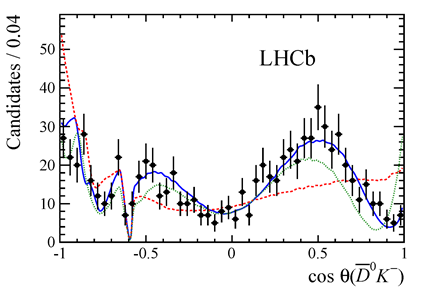Today at the 15th International Conference on B-Physics at Frontier Machines at the University of Edinburgh, Beauty 2014, the LHCb collaboration has presented the results of a study of strange beauty meson B0s decay into an anti-charm meson D0, a K– meson and a π+ meson (B0s → D0K–π+). Previous results indicated the existence of a strange-charm D*sJ(2860)– particle in the D0K– invariant mass spectrum, and the study of the B0s → D0K–π+ decay allows one to study this structure and measure its properties. Today’s LHCb observation shows with 10σ significance that, in fact, this excess seen in the D0K– mass spectrum is composed of two particles with different spins, spin-1 and spin-3. This is the first observation of a heavy flavored spin-3 particle, and the first time that any spin-3 particle has been seen to be produced in B decays.
The B0s → D0K–π+ decay is clearly identified as seen in the left image above. The right image above shows the enhancement at the 2.85 GeV/c2 mass in the D0K– invariant mass spectrum divided into two components as measured by LHCb physicists. The wider one corresponds to the spin-1 particle contribution and the narrow one represents the spin-3 contribution. The non-peaking distributions show contributions from other resonances that peak far from the 2.85 Gev/c2 D0K– mass region.
The left image shows to experts that the data D0K– angular distribution (black points) is very well described by the presence of both spin-1 and spin-3 particles (solid blue curve). The models with only either a spin-1 (red curve) or a spin-3 (green one) particle are not supported by data.
click the images for higher resolution
The D*sJ(2860)– particles are composed of an anti-charm quark c and a strange quark s. The quark-anti-quark pair is bound by strong interactions and can form different quantum states with different values of spin and angular momentum in analogy to the different quantum states of ordinary atoms. The presence of the spin-3 contribution gives a clear signature that both particles are members of the so called 1D family having two units of angular momentum between the quark and the antiquark. This discovery demonstrates that the spectroscopy of the 1D families of heavy flavoured mesons can be studied experimentally. Further insights can be expected with similar analysis of B decays at LHCb and the LHCb upgrade.
Read more in the LHCb presentation, in the CERN Courier article and soon in the LHCb publication.



